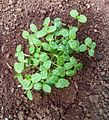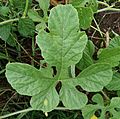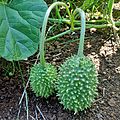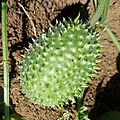Maroon cucumber facts for kids
Quick facts for kids Maroon cucumber |
|
|---|---|
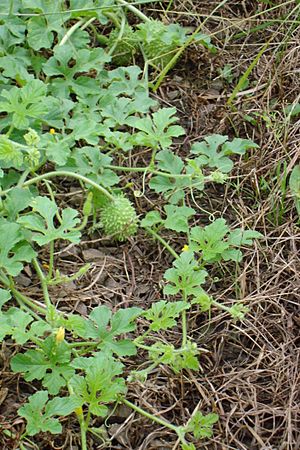 |
|
| Scientific classification | |
| Genus: |
Cucumis
|
| Species: |
anguria
|
| Varieties | |
|
|
| Synonyms | |
|
|
The Cucumis anguria is a plant known by many names. Some common names are maroon cucumber, West Indian gherkin, and burr gherkin. It is a type of vine plant.
This plant originally comes from Africa. However, it has spread and now grows naturally in many parts of the New World. People also grow it on farms in many places around the world. It is a close relative of the regular cucumber that you might eat.
Contents
What Does the Burr Gherkin Look Like?
The Cucumis anguria is a thin, green vine. It can grow quite long, sometimes up to 3 meters (about 10 feet). It likes to climb and spread out.
The plant produces small fruits. These fruits are usually oval or oblong in shape. They are about 4–5 centimeters (1.5–2 inches) long and 3–4 centimeters (1–1.5 inches) wide. The fruits grow on long stems.
The outside of the fruit is covered with long hairs. It also has small spines or bumps that look like warts. Inside, the fruit's flesh is a pale green color.
Where Does the Burr Gherkin Grow?
The Cucumis anguria plant first came from Africa. It is native to many African countries. These include Angola, Botswana, Malawi, Mozambique, Namibia, South Africa, Eswatini, Tanzania, Zambia, and Zimbabwe.
Over time, this plant has spread to many other parts of the world. It now grows naturally in places like Australia, Brazil, and many islands in the Caribbean. You can also find it growing in parts of the United States.
People also grow Cucumis anguria as a crop in other areas. These places include Cape Verde and Réunion.
How Do People Use the Burr Gherkin?
The main reason people grow Cucumis anguria is for its tasty fruit. The fruit can be used in many ways.
You can eat the fruits raw, just like a regular cucumber. They are also popular for pickling, which means preserving them in vinegar. Many people cook them as a vegetable.
In some parts of Brazil, especially in the northeast and north, Cucumis anguria fruits are very popular. They are often added to a local stew called cozido. The flavor of the burr gherkin is quite similar to that of a common cucumber.
Historically, some people have used Cucumis anguria in folk medicine. They believed it could help with stomach problems.
What Problems Can Affect Burr Gherkin Plants?
Like many plants, Cucumis anguria can face some challenges. Farmers need to protect their crops from certain issues.
The plants can be attacked by different types of fungi. These tiny organisms can cause plant diseases. Small insects like aphids can also harm the plants by sucking their sap. Another common problem is damage from cucumber beetles.
Gallery
See also
 In Spanish: Cucumis anguria para niños
In Spanish: Cucumis anguria para niños


